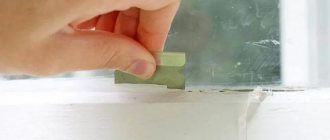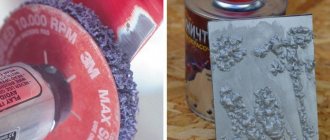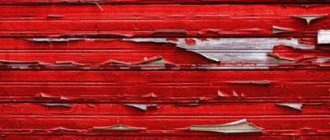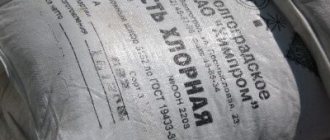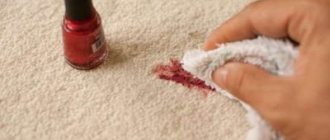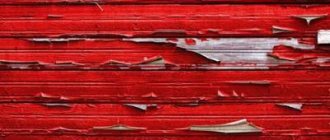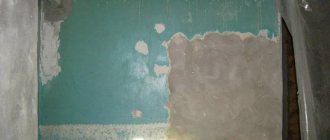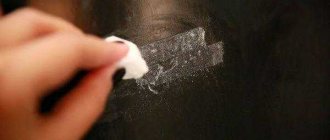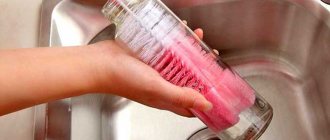Mechanical cleaning
This method is quite suitable for use at home: it does not require complex equipment or special skills. To clean the glass you will need:
- hot water;
- dishwashing liquid;
- a piece of clean cloth;
- blade or sharpened thin knife.
You can use a stationery knife, as well as a special scraper of the required size. If you don’t have anything at hand, then a hard metal dishwasher will do.
To begin, dissolve the detergent in a container of hot water and moisten the old paint on the glass with this solution. To prevent moisture from getting on freshly painted wooden window sills, they must be covered with film.
Scraping paint should be done at an optimal angle of 45 degrees. This will avoid the formation of cracks and scratches.
Removing drops of paint from glass is done with gentle movements and in one direction, periodically removing dirt from the blade. If the drop is wet enough, the stain will come off easily. Do not constantly move the tool from side to side - this will easily scratch the window glass.
The sound that the blade should make cannot be anything like grinding or squeaking. This may indicate a dull tool. In this case, it should be changed.
After the plastic window has been completely cleared of paint, they begin to wash the glass using a special product with a spray bottle.
Cleaning with chemicals
The chemical method of cleaning plastic windows has a number of advantages:
- ease of use;
- achieving high results;
- Possibility of removing stubborn or stubborn stains.
The main means of this method is the so-called wash. It can be purchased at any hardware store. You can familiarize yourself with the use of such a chemical on the label, but the principle of use is almost the same:
- Before removing the old paint from the window, it is worth carrying out preparatory work: clean the glass surfaces from visible dirt and dust.
- A remover is applied to the paint stains. The solution must remain on the dirt for some time so that the coating can swell.
- After curing, remove the peeling paint from the glass with a construction spatula or scraper and wipe the surface with a solvent.
- Finally, the plastic windows are washed with a solution prepared using water and vinegar.
The most convenient form of removing old paint is a paste - it does not run off the glass.
How to remove paint from concrete.
2. Concrete. At first glance, it seems that it is easiest to remove paint from a concrete wall. However, this apparent simplicity in practice turns out to be just the bravado of incompetent people. And when it comes to the actual work, yesterday’s “experts” shrug their shoulders, unable to give accurate recommendations for removing paint from concrete.
First you need to determine what kind of paint the concrete walls are painted with. If water-based paint is applied to the surface, you can use a spatula. This tool removes paint from concrete walls without any effort. If there is oil paint on the wall, it can be removed using a special remover. Before using this “chemical”, you need to carefully read the instructions in order to correctly calculate the proportions and find out the features of application. A few minutes after the wash is applied, the paint will begin to swell. As soon as this happens, it is necessary to remove it from the surface of the walls using a spatula.
How to choose what is best to clean a window?
The choice of method is determined by:
- the extent of the affected surface;
- how old the blots and drips are.
For fresh stains, simply using a damp cloth will solve the problem. And you will have to tinker with old traces of staining using the above methods.
For small stains, a mechanical method is suitable to remove splashes from the surface . In case of significant staining of glass with paint, chemical and thermal methods are suitable. High temperature treatment can also be used for old multi-layer stains.
When exposed to chemical reagents, it is necessary to strictly follow safety precautions and prevent solvents from getting on the frame and window sill. When working with windows, the use of solvents in a spray is undesirable, since it is difficult to control the coverage area.
Very often it is necessary to use several methods , combining them to obtain the best result.
Liquid chemicals used to remove paint are toxic.
Technology and consistency
Removing old paint from the plastic surface of a window, door or other element in a home interior is done as follows.
Immersion in solution
The easiest way to remove paint is from polystyrene. Washing is performed as follows. The panel from which the coating needs to be removed is immersed in a 20% solution of caustic potassium or soda (a 50% aqueous solution of caustic soda can also be used). For greater clarity, it is better to wash in a glass container.
After 4-5 hours, any paint (including acrylic, rubber or oil) will begin to bubble and move away from the surface of the plastic. To completely remove the previous coating, it is best to use an old toothbrush with increased rigidity.
For small surface areas of a window or door that need to be washed, you can use any solvent - solvent, acetone or white spirit. The easiest type to wash off is ABC grade plastics.
Compositions such as brake fluid and water-soluble compounds for cleaning sewer pipes such as “Mole” are quite effective for removing old paint from plastic.
Although their washing mechanism is different - brake fluid separates the coating layer by layer, and “Mole” simply dissolves the paint - the final effect turns out to be quite comparable.
After applying the chemical composition with a cotton swab or glass rod dipped in warm water, you should carefully wash off the remaining layers and areas of paint that have separated from the plastic.
Actively removes all types of paint from plastic plates - from water-based to alkyd enamel - methanol. However, the use of such a composition differs in two features:
- Methanol is toxic.
- After using it, clean the surface of the window, door, etc. It is necessary to rinse immediately with warm water, since traces of oil remain on it, and the cleaned product itself may turn yellow over time.
Methods for latex paints
Solvents are excellent for latex coatings. But the room must be ventilated during work, and hands must be protected with gloves. You can protect yourself by wearing special safety glasses.
Advice! Test the solution on a small area of plastic first to make sure it doesn't damage the surface.
White spirit also works great on latex paint stains: just 10-15 minutes and the solution can be washed off. Methanol will perfectly clean the surface, but it must be removed immediately, otherwise yellowness will remain on plastic products.
By the way, alkyd-based paint coatings also effectively remove white spirit; in addition to this substance, ammonia or a solvent is used. The main thing is that after application, after 15-20 minutes, completely clean the product of the applied product.
How to remove oil paint from walls - step by step diagram
Step 1: Apply wash
The remover should be applied with a brush or roller, working in one direction, without repeated applications to the same section of the wall. Try not to splash the remover, avoid contact with the skin. If this happens, rinse with warm water.
Step 2: The wash works
You won’t have to wait long - some solvents can do the job in a matter of minutes, as evidenced by characteristic visible reactions.
Step 3: Clean with a spatula
The paint softens and can be easily removed with a spatula or a metal brush. True, the wash does not always cope with all layers at once - in this case the process has to be repeated.
Step 4: Neutralize the remover
If possible (so as not to flood your neighbors), try to wash off the remaining chemicals from the wall - such an aggressive composition should not be left on the surface.
There are also more gentle, and most importantly, less expensive ways to get rid of paint using chemicals. For example, if we are talking about removing such a coating from a plank surface, you can get by with water and soda ash. We wet the surface generously, cover it with a decent layer of soda, cover it with damp burlap or any other rough cloth and wait a day, periodically wetting the cloth. With a spatula, paint swollen from dampness can be cleaned off easily and simply.
Folk remedies
If the glass is slightly dirty, it can be cleaned using available products. Old paint can be softened with any liquid oil. Sunflower fat is applied with a cotton swab to the problem surface and left to act. The enamel layers are removed with a spatula, and the window or mirror is thoroughly washed.
Vinegar, ammonia and soda Source severdv.ru
How to wipe off polyurethane foam and plaster
It is best to remove polyurethane foam from windows manually.
If you find foam immediately after installing the double-glazed window, then most likely it has not hardened yet, so do not remove it at the moment. When the polyurethane foam dries, it will separate much better from the glass surface. After hardening, it breaks and crumbles like foam. You can wipe off plaster from plastic windows with soapy water. If you fail to completely remove it the first time, do not despair; several repeated procedures will not leave a trace on the window.
The main thing to remember is that to clean a plastic window, you cannot use abrasive products, as well as a razor or knife, which can scratch the surface of the glass.
Getting rid of traces of plaster
After the window is installed, all cracks around the opening are sealed. As a result of such work, drops of plaster fall on the plastic. If you notice this right away, the stain can be easily removed with a damp cloth. But if the plaster has already dried, you will have to tinker a little. It is convenient to clean the mixture with a spatula wrapped in a rag - this way you will not scratch the plastic surface with sharp edges. Trim the dried plaster as close to the base as possible, and clean the remains with a stiff brush.
“Mechanical” options for removing protective film:
Option 1 Scraper + COSMOFEN
- Share
Excess film is removed with a scraper for cleaning glass-ceramic and hob surfaces.
Remains of adhesive and small scratches, if any, should be removed with COSMOFEN 10 or FENOSOL cleaner.
If there are no COSMOFEN 10 or FENOSOL cleaners, you can use an acrylic solvent, for example P-12.
Option 2 Hairdryer + COSMOFEN
- Share
We heat the film with an industrial hair dryer (or use a powerful “home” hair dryer). After which, quickly (until the protective film has cooled) and carefully, pry up the edge of the film with a scalpel (or a sharp stationery knife) and tear it off the window surface without stopping. We remove traces of glue, again, with COSMOFEN or acrylic solvent.
Option 3 Steam generator + COSMOFEN
Similar to method No. 2, but instead of an industrial hair dryer, you can use a steam generator. According to reviews, this method is more effective.
How to remove traces of liquid nails?
Materials such as liquid nails are very difficult to remove from plastic surfaces. Manufacturers recommend removing them with acetone or solvents No. 646, 647, 648. But these methods are absolutely not suitable for plastic windows. These substances are very aggressive, they corrode the plastic and spoil the appearance of the window.
Carefully study the composition of liquid nails, traces of which need to be removed. If they are water-based, they can be removed by preheating or freezing them. With this treatment, the stains lose their sticky properties. To heat the traces of liquid nails, you can take a steam generator or a hair dryer (both construction and regular ones will do). After heating, wipe off all dirt with the hard side of the sponge. For freezing, you can use regular ice from the freezer. You can also purchase special sprays. They are sold in pharmacies (for example, ICEMIX) and in hardware stores (these are used to remove chewing gum and plasticine). After freezing, liquid nails are removed with a spatula.
If liquid nails are solvent-based, they will be more difficult to handle. There are several options you can try here. Try scraping off the stains with a wallpaper knife or using nail polish remover (without acetone). Some types of liquid nails can be treated with alcohol. After trying several options, you can find one that will help remove all stains.
The golden mean - traditional methods
Folk remedies are more effective than mechanical methods and their financial costs are less than those of chemicals.
Ammonia solution
Cotton wool is soaked in diluted ammonia. It wipes glass with paint and varnish. The treatment area is dried with a paper towel. The glass surface, rubbed with ammonia, shines with shine.
Soda paste
A mixture of baking soda and water is prepared that looks like a thick porridge. Soda paste is applied to the blot for a few minutes. After the time has passed, the soda is removed. The blot can be easily removed with a blade or a construction knife.
Composite composition of three components
A composition is prepared from three simple components, which are taken in proportions:
- Lime – 30 gr.;
- Chalk – 10 g;
- Caustic soda – 10 gr.
In a dry state, mix chalk and soda. The dry composition is diluted with water until it becomes homemade sour cream. Soda is added.
The prepared gruel is applied to the contaminated area and left for several hours.
The paintwork dissolves under its influence. The remains are removed with a construction knife. No special effort is required.
Interesting video on the topic:
Frame and glass cleaners
Special detergents will help to clean windows after completion of repair work:
- Mr. Muscle - when following the instructions, it easily copes with many dirty stains and does not leave behind streaks.
- Phenozol is a cleaning agent for plastic profiles; it can be used to easily remove traces of foam.
- Bref is an effective and affordable detergent.
- Mr. Proper - Great for glass cleaning and polishing.
- Solvent 646 - helps to easily remove remnants of primer and paint.
Traces of whitewash
Usually, whitewash is very easy to remove with a dry cloth (you shouldn’t use a damp cloth, as this will only spread the whitewash over the surface). But after the bulk of the dirt has been removed, you can wash the window clean. To do this, use a soap solution (for plastic surfaces) and a glass cleaner. You can also prepare a homemade detergent: add 1 tablespoon of ammonia and 2 tablespoons of vinegar to 2 liters of water.
If lime whitewash was used during renovation work, it will not be so easy to remove. Traces of lime will have to be scraped off the glass with a blade or knife. To clean plastic surfaces, you can use different means:
- Industrial product Cillit. It must be diluted with water in a 1:1 ratio, applied to traces of whitewash and after a few minutes removed with a hard sponge. Before use, test the product on an inconspicuous area of the window sill, as it contains oxalic acid.
- Try cleaning the limescale with a vinegar solution. For one bucket of water you will need only one tablespoon. Instead of vinegar, you can use citric acid.
- There is another solution that will help deal with lime. Just dilute one glass of salt in a bucket of water.
- Vegetable oil can also be used to clean the profile. Add 100 grams per 10 liters of water and wash the windows with this solution. After all dirt has been removed, the profile is washed again using dishwashing detergent.
Paint Removal Tips
Before starting work, you need to wear gloves , especially if the work will be carried out with aggressive agents such as gasoline. This will not only protect the skin of your hands, but will also prevent you from getting stained with paint.
It is advisable to cover surfaces located near the workplace with something (for example, cling film) to prevent paint from getting in, but this is not necessary.
After finishing work, you need to wipe the window with a dry cloth, and also be sure to ventilate the room - the use of toxic substances can cause serious harm, especially if you inhale these vapors for a long time.
There is no need to try to scrape off dry paint - this will only further damage the surface being cleaned. Paint stains should always be softened and wetted to prevent scratches.
Precautionary measures
To facilitate repair work, observe the following precautions:
- Before painting, wipe the windows with soapy water. Paint, if it gets on the surface of the window, will not stick to the window and will be removed from the surface without problems.
- When working with chemicals, try to ventilate the room so that harmful fumes do not enter the body along with the air.
- If possible, clean the glass in a horizontal position. This will reduce the risk of breaking it.
Many housewives are interested in how to clean windows after renovation or in a new building. For this procedure, it is recommended to use special or home remedies that are always at hand. The process is labor-intensive, but you can handle it yourself.
Homemade solutions
There is not always available cash to purchase special chemicals for cleaning paint. Ingenuity and skillful hands will come to the rescue. Homemade solution consists of:
- caustic soda;
- slaked lime;
- crushed chalk
First, mix lime and chalk until smooth, and then add soda. The ideal consistency should look like thick sour cream.
Apply the prepared paste to the stains and leave the mixture for several hours. After the specified time has passed, you can easily remove the dirt with a spatula. The method is considered inexpensive compared to thermal and chemical ones.
